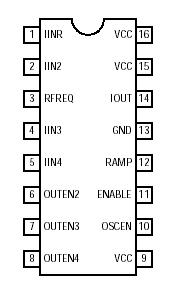Features: • Shrink-Small Outline Package
• Voltage-controlled output current source requiring one external set resistor per channel
• Current-controlled output current source
• Rise time = 3.0ns
• Fall time = 3.5ns
• On-chip oscillator with frequency and amplitude control by use of external resistors to ground
• Oscillator to 500MHz
• Oscillator to 100mA pk/pk
• Single +5V supply (±10%)
• Current amplification = 100
• Disable feature for power-up protection and power savings
• TTL/CMOS control signals
Application• CD-RW applications
• Writable optical drives
• Laser diode current switching
Pinout Description
Description The EL6275C is a four channel laser diode current amplifier that provides controlled current to a grounded laser diode. Channels 2, 3, and 4 should be used as the write channels, with switching speeds of approximately three nanosecond rise/fall time. All four channels are summed together at the I
OUT output, allowing the user to create multilevel waveforms in order to optimize laser diode performance. The level of the output current is set by an analog voltage applied to an external resistor which converts the voltage into a current at the I
IN pin (virtually ground). The current seen at this pin is then amplified to become a current source at pin I
OUT.
An on-chip 500MHz oscillator EL6275C is provided to allow output current modulation when in any mode. This is turned on when the OSCEN pin is held high. Complete control of amplitude and frequency is set by two external resistors connected to ground at pins R
FREQ and R
AMP (see graphs in this data sheet for further explanation).
Output current pulses EL6275C are enabled when an 'L' signal is applied to the OUTEN pin. No output current flows when OUTEN is 'H' and additional laser diode protection is provided since the OUTEN input will float high when open. Complete IOUT shutoff is also achieved by holding the ENABLE pin low, which will override all other control pins.
The external resistors EL6275C allow the user to accurately and independently set each amplifier transconductance by applying a voltage to each resistor, without restriction on the voltage range, thus ensuring broad voltage DAC compatibility. Alternatively, the IIN pin can be biased from a current DAC or other current source.

 EL6275C Data Sheet
EL6275C Data Sheet







